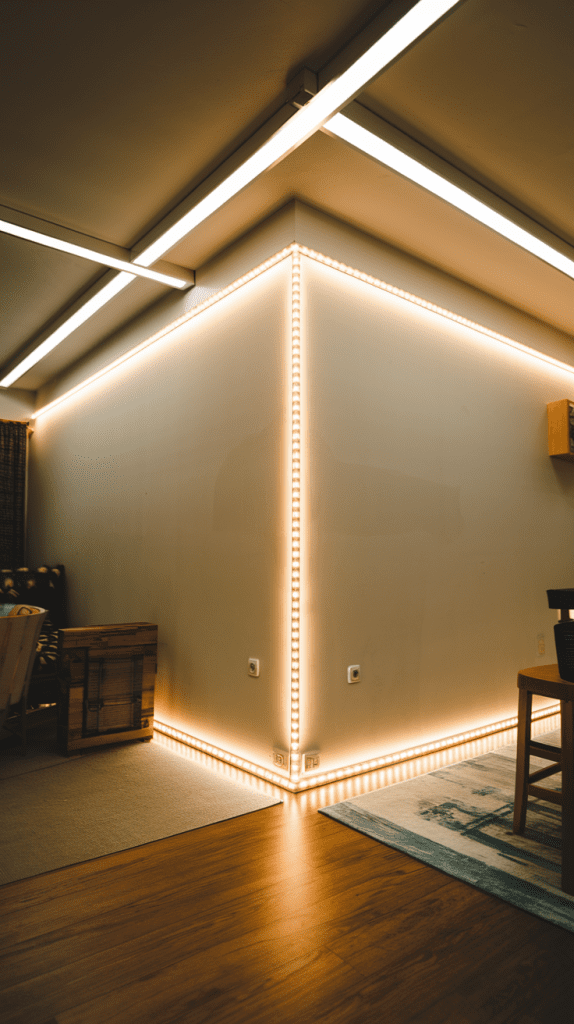Transforming Your Room With LED Strip Lights: How To Set up LED Strip Lights in a Room?
Ready to add a touch of magic to your living space? This guide will walk you through everything you need to know about how to set up LED strip lights in a room. We’ll cover everything from choosing the right lights to connecting them, troubleshooting common issues, and maximizing their potential to create the perfect…
Ready to add a touch of magic to your living space? This guide will walk you through everything you need to know about how to set up LED strip lights in a room. We’ll cover everything from choosing the right lights to connecting them, troubleshooting common issues, and maximizing their potential to create the perfect ambiance. You’ll learn about different types of LED strips, power supplies, controllers, and installation techniques, ensuring you can successfully illuminate your room with stunning LED lighting.
LED strip lights are flexible circuits containing numerous small LEDs, often encased in a silicone coating for protection. They offer a versatile and energy-efficient way to add ambient, accent, or task lighting to any space. They come in various colors, lengths, and brightness levels, allowing for extensive customization.
How to Set Up LED Strip Lights in a Room?
Types of LED Strip Lights

LED strip lights are available in various types, each with unique features:
- Non-waterproof (Indoor use): These are the most common and affordable type, perfect for indoor applications.
- Waterproof (Indoor/Outdoor use): These feature a protective coating, making them suitable for damp environments or outdoor use.
- RGB Strip Lights: These allow you to change the color of the lights using a controller, offering a wide range of customization options.
- Addressable RGB Strip Lights (e.g., WS2812B): These strips allow for individual control of each LED, enabling complex lighting effects and patterns.
Choosing the Right LED Strip Lights
Brightness and Color Temperature
Consider the lumens (brightness) and color temperature (Kelvin) of the lights. Higher lumens mean brighter lights. Color temperature ranges from warm white (2700K – yellowish) to cool white (6500K – bluish).
Length and Power Supply
LED strip lights come in various lengths. Ensure you purchase a long enough strip for your intended application and a power supply that can handle the wattage requirements of your chosen strip. Too low of wattage and the lights will be dimmer than expected or even fail to work.
Essential Tools and Materials
Gathering Your Supplies
Before you begin, gather the following:
- LED Strip Lights
- Power Supply (12V or 24V, depending on your strip lights)
- Controller (for RGB or addressable RGB strips)
- Connectors (if necessary)
- Adhesive tape (usually provided with the strips)
- Wire strippers/cutters
- Soldering iron (if you need to make custom connections)
- Measuring tape
- Optional: Mounting clips
Planning Your LED Strip Light Installation

Measuring and Planning Your Layout
Carefully measure the areas where you want to install your LED strip lights. Plan your layout beforehand to ensure optimal placement for the desired lighting effects. Consider where the power supply will be located and how to best conceal the wiring.
Installing LED Strip Lights: A Step-by-Step Guide
Preparing the Surface
Clean the surface where you’ll be adhering the LED strip lights. Make sure it’s free of dust, dirt, and grease for optimal adhesion.
Adhering the LED Strips
Carefully peel the backing off the adhesive tape on the LED strip lights and adhere them to the surface, ensuring they are securely attached.
Connecting the Power Supply
Connect the power supply to the LED strip lights, following the instructions provided with your specific lights and power supply. Ensure proper polarity (+ and -).
Connecting the Controller (if applicable)
If you’re using RGB or addressable RGB strips, connect the controller according to the manufacturer’s instructions. This will allow you to control the color and effects of your lights.
Testing Your Installation
Once everything is connected, plug in the power supply and test your LED strip lights to ensure they are working correctly. Check for any loose connections or faulty LEDs.
Troubleshooting Common Issues
Lights Not Turning On
Check the power supply, connections, and fuses. Ensure the power supply is plugged in and working properly. Examine all connections for any loose wires or incorrect polarity.
Dim or Flickering Lights
This could be due to insufficient power, loose connections, or a faulty power supply. Try a different power supply with higher wattage if needed.
Uneven Lighting
Inspect the LED strip for any damaged or faulty LEDs. Ensure that all connections are secure and the power supply is providing adequate power.
Advanced Techniques and Customization
Creating Custom Lighting Effects (with addressable LEDs)
Addressable LED strips offer extensive customization through software and controllers. You can create complex patterns, animations, and effects, limited only by your imagination and the capabilities of your controller and software.
Integrating with Smart Home Systems
Many LED strip lights and controllers are compatible with smart home systems like Google Home, Amazon Alexa, and Apple HomeKit, allowing you to control your lights remotely and automate lighting scenes.
Benefits of Using LED Strip Lights
Energy Efficiency
LEDs are significantly more energy-efficient than traditional incandescent or fluorescent lighting, saving you money on your electricity bill.
Versatility and Design Flexibility
LED strip lights can be used in a wide range of applications and spaces, offering significant design flexibility.
Long Lifespan
LEDs have a much longer lifespan than traditional light bulbs, reducing the need for frequent replacements.
Limitations of LED Strip Lights
Heat Generation (in some cases)
High-density LED strips can generate heat, so proper ventilation is important, especially for high-wattage strips.
Sensitivity to Water (for non-waterproof strips)
Non-waterproof strips should never be used in wet locations. Water damage can be irreversible.
Comparing LED Strip Lights: Features and Prices
Different Brands and Their Offerings
Various brands offer LED strip lights with varying features, prices, and quality. Research different brands to find the best option for your needs and budget. Consider factors like warranty, customer support, and reviews.
DIY vs. Professional Installation
Assessing Your Skill Level
While installing LED strip lights is generally straightforward, assess your DIY skills before attempting installation. If you’re unsure, consider hiring a professional electrician to ensure a safe and proper installation.
Safety Precautions
Electrical Safety
Always disconnect the power supply before working with LED strip lights or their connections. Never work with electricity if you are unsure of what you’re doing. Consult a qualified electrician if needed.
Frequently Asked Questions
What are the different types of LED strip light adhesives?
Most LED strip lights come with a self-adhesive backing, usually a 3M adhesive, which is strong enough for most surfaces. Some higher-end strips might have more advanced adhesives for easier application or better adhesion to certain surfaces. For more secure mounting, especially in high-traffic areas or places with vibrations, you can supplement the self-adhesive with additional adhesive or mounting clips.
Can I cut LED strip lights?
Yes, but only at designated cutting points indicated on the strip. Cutting at other locations can damage the circuit and render the lights inoperable. Be sure to use appropriate wire connectors for any cut ends to maintain a proper electrical connection.
How do I choose the right power supply for my LED strip lights?
The power supply’s voltage must match the voltage of your LED strip lights (usually 12V or 24V). The amperage (A) of the power supply should be equal to or greater than the total amperage required by the LED strip. This information is usually found on the LED strip’s specifications. A power supply with insufficient amperage will result in dim lights or malfunction. A higher amperage is preferable as it leaves room for future expansion.
Final Thoughts
Setting up LED strip lights in your room is a rewarding project that can dramatically enhance your home’s ambiance. By carefully following the steps outlined in this guide, you can achieve a stunning and personalized lighting setup. Remember to prioritize safety, plan your layout, and choose the right components for your needs. Whether you’re creating a cozy movie night atmosphere or adding a vibrant splash of color to your gaming room, LED strip lights offer endless possibilities for customization and enhancement. With a little planning and attention to detail, you can transform your space into a visually captivating haven. So, gather your supplies, follow the steps, and enjoy the beautiful, customized lighting you’ve created!

